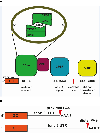HIV-1-induced translocation of CPSF6 to biomolecular condensates
- PMID: 38267295
- PMCID: PMC11263504
- DOI: 10.1016/j.tim.2024.01.001
HIV-1-induced translocation of CPSF6 to biomolecular condensates
Abstract
Cleavage and polyadenylation specificity factor subunit 6 (CPSF6, also known as CFIm68) is a 68 kDa component of the mammalian cleavage factor I (CFIm) complex that modulates mRNA alternative polyadenylation (APA) and determines 3' untranslated region (UTR) length, an important gene expression control mechanism. CPSF6 directly interacts with the HIV-1 core during infection, suggesting involvement in HIV-1 replication. Here, we review the contributions of CPSF6 to every stage of the HIV-1 replication cycle. Recently, several groups described the ability of HIV-1 infection to induce CPSF6 translocation to nuclear speckles, which are biomolecular condensates. We discuss the implications for CPSF6 localization in condensates and the potential role of condensate-localized CPSF6 in the ability of HIV-1 to control the protein expression pattern of the cell.
Keywords: CPSF6; HIV-1; alternative polyadenylation; biomolecular condensates; nuclear speckles.
Copyright © 2024 Elsevier Ltd. All rights reserved.
Conflict of interest statement
Declaration of interests No interests are declared.
Figures



Similar articles
-
CPSF6 promotes HIV-1 preintegration complex function.J Virol. 2025 May 20;99(5):e0049025. doi: 10.1128/jvi.00490-25. Epub 2025 Apr 9. J Virol. 2025. PMID: 40202316 Free PMC article.
-
HIV-1 usurps mixed-charge domain-dependent CPSF6 phase separation for higher-order capsid binding, nuclear entry and viral DNA integration.Nucleic Acids Res. 2024 Oct 14;52(18):11060-11082. doi: 10.1093/nar/gkae769. Nucleic Acids Res. 2024. PMID: 39258548 Free PMC article.
-
Detection of CPSF6 in Biomolecular Condensates as a Reporter of HIV-1 Nuclear Import.Methods Mol Biol. 2024;2807:127-138. doi: 10.1007/978-1-0716-3862-0_9. Methods Mol Biol. 2024. PMID: 38743225
-
HIV-Induced CPSF6 Condensates.J Mol Biol. 2023 Aug 15;435(16):168094. doi: 10.1016/j.jmb.2023.168094. Epub 2023 Apr 14. J Mol Biol. 2023. PMID: 37061085 Review.
-
Emerging Roles of Biomolecular Condensates in Pre-mRNA 3' End Processing.Wiley Interdiscip Rev RNA. 2025 Jul-Aug;16(4):e70024. doi: 10.1002/wrna.70024. Wiley Interdiscip Rev RNA. 2025. PMID: 40804711 Review.
Cited by
-
Correlative In Situ Cryo-ET Reveals Cellular and Viral Remodeling Associated with Selective HIV-1 Core Nuclear Import.bioRxiv [Preprint]. 2025 Mar 4:2025.03.04.641496. doi: 10.1101/2025.03.04.641496. bioRxiv. 2025. Update in: Nat Microbiol. 2025 Aug;10(8):1868-1885. doi: 10.1038/s41564-025-02054-z. PMID: 40093063 Free PMC article. Updated. Preprint.
-
Disruption of LEDGF/p75-directed integration derepresses antisense transcription of the HIV-1 genome.bioRxiv [Preprint]. 2024 Dec 6:2024.12.06.627169. doi: 10.1101/2024.12.06.627169. bioRxiv. 2024. PMID: 39677798 Free PMC article. Preprint.
-
CPSF6 promotes HIV-1 preintegration complex function.J Virol. 2025 May 20;99(5):e0049025. doi: 10.1128/jvi.00490-25. Epub 2025 Apr 9. J Virol. 2025. PMID: 40202316 Free PMC article.
-
HIV-1 nuclear import is selective and depends on both capsid elasticity and nuclear pore adaptability.Nat Microbiol. 2025 Aug;10(8):1868-1885. doi: 10.1038/s41564-025-02054-z. Epub 2025 Jul 7. Nat Microbiol. 2025. PMID: 40624219 Free PMC article.
-
Identification and characterization of survival-dependent genes in esophageal cancer via the DepMap database: unraveling their association with immune infiltration.Discov Oncol. 2025 Jun 22;16(1):1176. doi: 10.1007/s12672-025-02942-0. Discov Oncol. 2025. PMID: 40544380 Free PMC article.
References
Publication types
MeSH terms
Substances
Grants and funding
LinkOut - more resources
Full Text Sources

